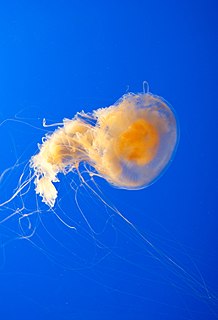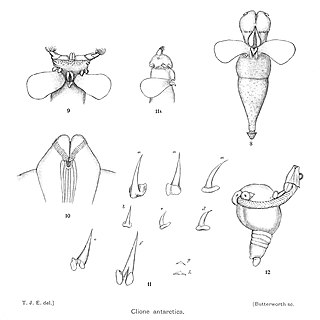
Cnidaria is a phylum under kingdom Animalia containing over 11,000 species of aquatic animals found both in freshwater and marine environments, predominantly the latter.

Jellyfish and sea jellies are the informal common names given to the medusa-phase of certain gelatinous members of the subphylum Medusozoa, a major part of the phylum Cnidaria. Jellyfish are mainly free-swimming marine animals with umbrella-shaped bells and trailing tentacles, although a few are anchored to the seabed by stalks rather than being mobile. The bell can pulsate to provide propulsion for highly efficient locomotion. The tentacles are armed with stinging cells and may be used to capture prey and defend against predators. Jellyfish have a complex life cycle; the medusa is normally the sexual phase, which produces planula larva that disperse widely and enter a sedentary polyp phase before reaching sexual maturity.

The Scyphozoa are an exclusively marine class of the phylum Cnidaria, referred to as the true jellyfish.

Aurelia aurita is a species of the genus Aurelia. All species in the genus are very similar, and it is difficult to identify Aurelia medusae without genetic sampling; most of what follows applies equally to all species of the genus. The most common method used to identify the species consists of selecting a jellyfish from a harbour using a device, usually a drinking glass and then photographing the subject. This means that they can be released in to the harbour shortly afterwards and return to their natural habitat.

Medusozoa is a clade in the phylum Cnidaria, and is often considered a subphylum. It includes the classes Hydrozoa, Scyphozoa, Staurozoa and Cubozoa, and possibly the parasitic Polypodiozoa. Medusozoans are distinguished by having a medusa stage in their often complex life cycle, a medusa typically being an umbrella-shaped body with stinging tentacles around the edge. With the exception of some Hydrozoa, all are called jellyfish in their free-swimming medusa phase.

The Ulmaridae are a family of jellyfish.

Jellyfish Lake is a marine lake located on Eil Malk island in Palau. Eil Malk is part of the Rock Islands, a group of small, rocky, mostly uninhabited islands in Palau's Southern Lagoon, between Koror and Peleliu. There are about 70 other marine lakes located throughout the Rock Islands. Millions of golden jellyfish migrate horizontally across the lake daily.

Phacellophora camtschatica, commonly known as the fried egg jellyfish or egg-yolk jellyfish, is a very large jellyfish in the family Phacellophoridae. This species can be easily identified by the yellow coloration in the center of its body which closely resembles an egg yolk, hence how it got its common name. Some individuals can have a bell close to 60 cm (2 ft) in diameter, and most individuals have 16 clusters of up to a few dozen tentacles, each up to 6 m (20 ft) long. A smaller jellyfish, Cotylorhiza tuberculata, typically found in warmer water, particularly in the Mediterranean Sea, is also popularly called a fried egg jellyfish. Also, P. camtschatica is sometimes confused with the Lion's mane jellyfish.

Turritopsis dohrnii, also known as the immortal jellyfish, is a species of small, biologically immortal jellyfish found worldwide in temperate to tropic waters. It is one of the few known cases of animals capable of reverting completely to a sexually immature, colonial stage after having reached sexual maturity as a solitary individual. Others include the jellyfish Laodicea undulata and species of the genus Aurelia.

Atolla wyvillei, also known as the Atolla jellyfish or Coronate medusa, is a species of deep-sea crown jellyfish. It lives in oceans around the world. Like many species of mid-water animals, it is deep red in color. This species was named in honor of Sir Charles Wyville Thomson, chief scientist on the Challenger expedition.

Chrysaora hysoscella, the compass jellyfish, is a common species of jellyfish that inhabits coastal waters in temperate regions of the northeastern Atlantic Ocean, including the North Sea and Mediterranean Sea. In the past it was also recorded in the southeastern Atlantic, including South Africa, but this was caused by confusion with close relatives; C. africana, C. fulgida and an undescribed species tentatively referred to as "C. agulhensis".

The flower hat jelly is a species of hydromedusa in the hydrozoan family Olindiidae. Although they look like a jellyfish, they actually belong in the class Hydrozoa, while true jellyfish belong in class Scyphozoa. Flower hat jellies occur in the northwestern Pacific off central and southern Japan, and South Korea's Jeju Island.. The adult form of the flower hat jelly only lives a few months and is typically seen from December to July, with peaks in April and May. During the day they rest on the bottom, often among rocks or algae, but at night they float up to hunt for their prey, typically small fish.

Aurelia is a genus of scyphozoan jellyfish, commonly called moon jellies. There are currently 25 accepted species and many that are still not formally described.

Cyanea is a genus of jellyfish, primarily found in northern waters of the Atlantic and Pacific Oceans and southern Pacific waters of Australia and New Zealand, there are also several boreal, polar, tropical and sub-tropical species. Commonly found in and associated with rivers and fjords. The same genus name has been given to a genus of plants of the Hawaiian lobelioids, an example of a parahomonym.

Limacina rangii is a species of swimming sea snail in the family Limacinidae, which belong to the group commonly known as sea butterflies (Thecosomata).

Clione antarctica is a species of "sea angel", a sea slug, a pelagic marine gastropod mollusk in the family Clionidae, the "sea angels".

The helmet jellyfish is a luminescent, red-colored jellyfish of the deep sea, belonging to the order Coronatae of the phylum Cnidaria. It is the only species in the monotypic genus Periphylla. They are the only known scyphozoan to undergo sexual propagation that lacks a planula stage. Not only is their reproductive cycle unique, so are their living conditions. They are found in deeper parts of the ocean due to them being photophobic.

Lipkea is a genus of stalked jellyfish. It is the only genus in the monotypic family Lipkeidae. Lipkea species lack tentacles at the end of their bell.

Poralia is a genus of jellyfish in the family Ulmaridae. It is a monotypic genus containing a single species, Poralia rufescens. This jellyfish is pelagic, and is found in deep water in most of the world's oceans.

Desmonema is a genus of jellyfish under the Cyaneidae family found in colder waters near the Antarctic region and off of the coast of Argentina. They have a bell diameter that can extend over 1 meter and wide tentacles that are grouped together in clusters. They share similar anatomical and physiological structures to the genus Cyanea. Their sophisticated structures like the thick tentacles, sensory systems, and gastrovascular system allow Desmonema to easily capture and extracellularly digest their prey. In recent years, Desmonema were reported to have a commensal relationship with fishes under the Trachurus genus and a parasitic relationship with specimens of the Hyperia genus.



















